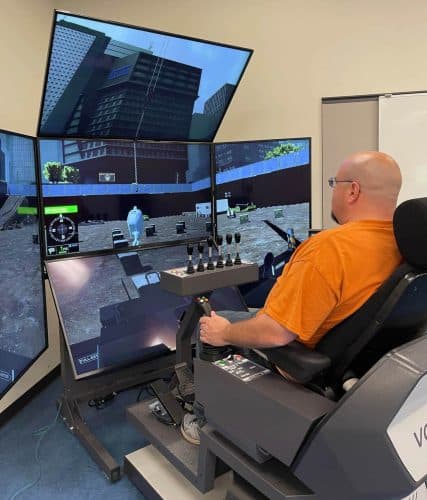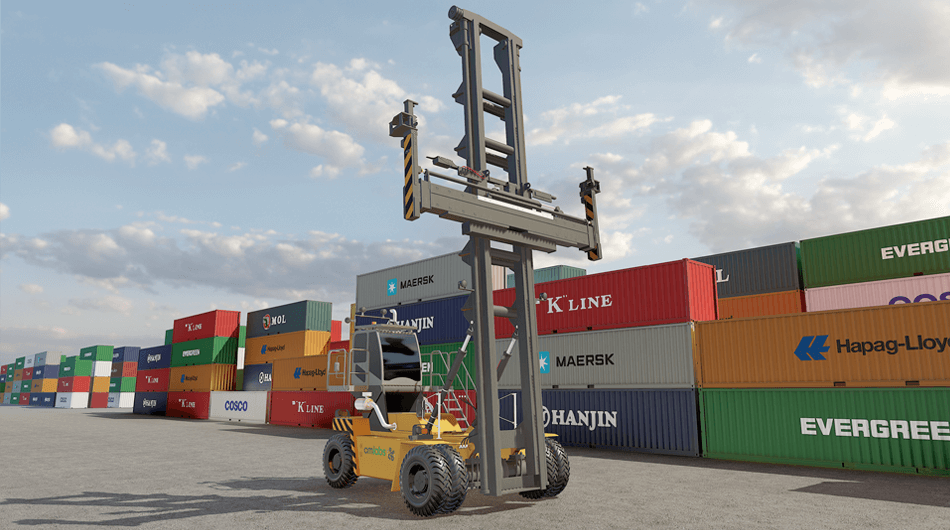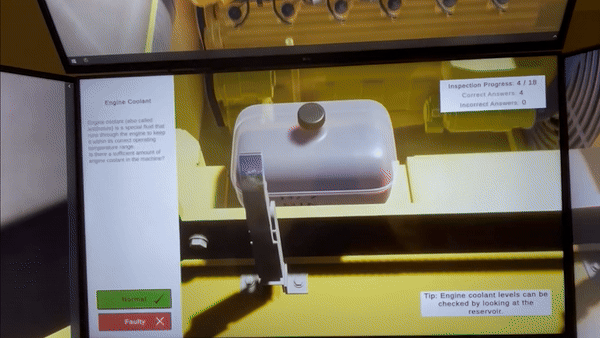Addressing Worker Safety Head On
Overhead, underground, or in the streets, utility workers face more than their share of hazards. Consequently, the industry consistently ranks among the top ten most dangerous workplaces. Thanks largely to the progressive training programs from Electrical Training ALLIANCE (ETA), safety improvements are taking effect and according to the U.S. Bureau of Labor Statistics, the number of electrical worker job fatalities is steadily declining.
As a joint initiative between the National Electrical Contractors Association (NECA) and the International Brotherhood of Electrical Workers (IBEW), ETA provides curriculum and training to ensure a safe workplace for more than 55,000 apprentices and 700,000 journeymen. Recognized as the industry’s leading publisher of educational materials, the organization’s blended learning approach has seen a shift from paper to technology with a growing emphasis on simulation-based training.
Training Simulators
Believing that crane safety was too important for simply traditional training methods, ETA enhanced its arsenal of simulators to include equipment operator training. Virgil Melton, Director at ETA, was heavily involved in the purchase of a CM Labs crane simulator.
“I was amazed at the detail and realism. The simulator’s controls and reactions were as close to real as it gets. I could physically see, feel, and hear what was happening. If I weren’t in a classroom, I’d swear I was on an actual crane. I was doing a presentation and the crane simulator, along with some others we have, really struck a lot of interest in the crowd.”
Melton was sold. In addition to the crane simulation training pack, ETA purchased boom truck and earthmoving equipment simulations along with an Instructor Operating Station (IOS). With CM Labs’ embedded Smart Training Technology™, they are the only simulations that accurately replicate machine behavior; helping accelerate learning, and deliver measurable productivity and safety gains.
Here are 8 areas where organizations like ETA leverage simulation-based training.
1. Fail without Consequences
With the ability to replicate the worksite environment, equipment response, tasks, and weather conditions, CM Labs’ simulators allow trainees to become comfortable with equipment and hazards, and make mistakes virtually – without costly or dangerous consequences.
“With a simulator, if somebody doesn’t do something correctly, you just hit reset. You don’t have to spend half-a-million dollars on a piece of equipment,” said Melton. “Even in a training yard, if a piece of equipment is turned over, you’re out hundreds of thousands of dollars. And you can buy a lot of simulators and put a lot of people through training for half a million dollars.”


2. Prepare for Certification & Recertification
Engaging students with real-world scenarios have shown to increase learning and retention over classroom instruction or printed materials alone, and this translates into higher certification exam success. Similarly, journeymen operators benefit with respect to recertification, cross-training, upskilling, or keeping current with best practices or new equipment features.
3. Track Training Progress
The CM Labs IOS allows ETA’s instructors to track trainee success throughout the process – from the beginning to the exam. Instructors can maintain one-on-one interaction, set scoring targets, and monitor progress. The IOS reinforces ETA’s mission to work safely: instructors can, in real-time, trigger unexpected events, night or day scenarios, precipitation and wind, and insert faults into exercises.
4. Anytime Equipment Access and Extend Your Fleet of Equipment
One of ETA’s ongoing challenges is whether to remove a piece of revenue-generating equipment from service for training. Simulations are available anytime, allowing you to train more people, on more machines, without sacrificing profitability or dealing with inclement weather.
5. For All Levels of Operator Experience
Somewhat surprisingly, the fatal work injury rate within the utility industry increases with age. This could indicate that, as they settle in, workers become overly confident or complacent. ETA makes simulators available to workers at all levels providing certification, and recertification, advanced continuing education to ensure safety does not become an afterthought.
“Our apprentices have fewer accidents than our journeymen,” Melton explained. “We sometimes hear how an apprentice helps a journeyman avoid danger because of what was learned in class.”

6. Build Confidence
The electrical industry can be intimidating to the inexperienced. Simulators close the gap from the classroom to the field by providing a safe, controlled, setting while closely replication worksite and equipment environments. Complete with all the pressure and distractions, sessions can be intense; however, simulators allow trainees to make mistakes without costly or dangerous consequences.
Melton has seen how this familiarity builds levels of comfort and confidence. “As an instructor, you take a student out to the field, and they see this huge piece of sophisticated equipment, and they are understandably intimidated. But when they start on the crane simulator, for example, their comfort level increased dramatically.”
7. Save Costs
Fuel consumption, maintenance, and repair cost of field training can be substantial. Simulators provide a cost-effective, measurable return on investment. By mirroring actual equipment controls, performance, and working conditions, simulators provide all the advantages of training on actual equipment without sacrificing profitability.
8. Reduce Accidents
OSHA fines, equipment damage, injury, worker absence, insurance claims, and litigation can have catastrophic consequences. Assisted by simulator training, ETA is seeing a measurable reduction in incidents and infractions.
“We have a committee that tracks accidents, near misses, and other unsafe practices and shares that data with the organization. It seems like every time we have a meeting, we hear of fewer and fewer accidents or near misses.”
Bring Training to Life
Melton explained that many instructors within the organization shared his initial apprehension. Things have quickly changed and they have become leading advocates for simulation-based training.
“They soon found simulators to be a valuable training tool that allowed them more time in the yard for hands-on training. I can talk until I’m blue in the face, but when somebody sees it and puts their hands on it, I’m done talking. I want to give an instructor a tool to work with and then have them come back and give me ideas on how to use it even more.”
For this industry, the days of paper-based instruction are over. Leading organizations like ETA are continuing to set the pace in advancing safety by leveraging simulation technology for the most effective training solutions.






